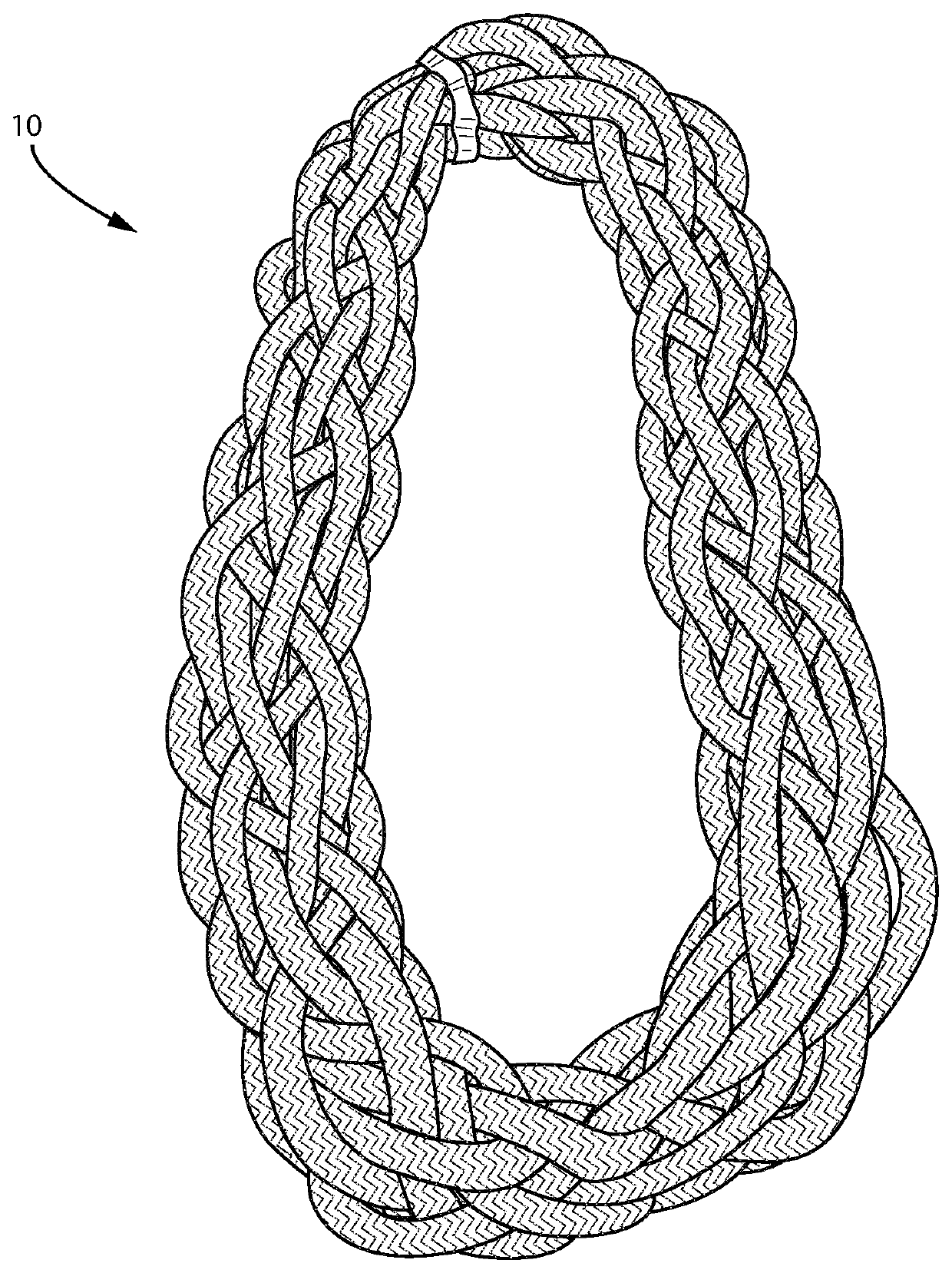Chain with endless braided chain-link
a chain link and chain technology, applied in the field of chains, can solve the problems of high maximum break load chain-links with such constructions suffering a substantial efficiency loss, and the chain is prone to extensive abrasion and other problems, and achieve the effect of reducing the payload
- Summary
- Abstract
- Description
- Claims
- Application Information
AI Technical Summary
Benefits of technology
Problems solved by technology
Method used
Image
Examples
example 1
[0052]A primary strand was braided from a total of 12 sub-strands, each sub-strand consisting of 7×15 Dyneema DM20 1760 dtex yarns as employed for the narrow weave of the Comparative Examples. Accordingly, the primary strand was a braided rope construction of 12×7×15×1760 dtex (2217600 dtex) with a diameter of about 20 mm and a strength of 400 kN. A single length of about 20 m of said primary strand was used to construct a first chain-link by starting from an end of the 20 m primary strand and forming a loop of about 3 m length (1 m diameter). With the remainder of the primary strand a total of 11 further loops were formed along the first circle in such a way that the 12 loops form a first Turk's head braided chain link construction from these 12 loops of the single primary strand whereby the pitch of the braid was about 10. The two free ends of the primary strand were buried inside the Turk's head braided chain-link construction. An alternative description of the braided chain-link...
example 2
[0054]A chain construction similar to the one of Example 1 was prepared with the difference that the braided primary strand was braided from 12 sub-strands each sub-strand consisting of only 4 Dyneema DM20 1760 dtex yarns resulting in a braided rope construction of 84480 dtex with a diameter of about 5 mm and a strength of about 20 kN. From said primary strand braided chain-links with a diameter of about 0.3 m have been prepared, starting from about 4 m of said primary strand for each chain-link. Further details and MBL of the chain are reported in Table 1.
example 3
[0055]A chain similar to the chain of Example 2 was prepared and further coated by impregnating it with an aqueous suspension of a very-low density polyethylene plastomer commercially available as Queo® (supplier Borrealis GmbH), dried for 24 hours at room temperature, resulting in a weight increase of about 20 wt %. Subsequently each of the braided chain-links was heat set for 7 minutes and 120° C. at 2 t load (about 10% of the MBL of the link). Details and break performance of the chain is provided in Table 1.
[0056]
TABLE 1Maximum break load and tenacity of chains2 legs ofChainBasic strandTurnscoresMBLtenacity[tex](Loops)Legs[Mtex][kN][N / tex]Comp. 1Weave:820.436217.10.5027280Comp. 2Weave:1220.655329.80.5027280Comp. 3MF* Yarn:1620.0056322.80.50176Example 1Rope:1225.3230810.58221760Example 2Rope: 84481220.203137.250.67Example 3Rope: 84481220.203166.40.86MF* Yarn = multifilament yarn (tex)
PUM
| Property | Measurement | Unit |
|---|---|---|
| diameter | aaaaa | aaaaa |
| diameter | aaaaa | aaaaa |
| diameter | aaaaa | aaaaa |
Abstract
Description
Claims
Application Information
 Login to View More
Login to View More - R&D
- Intellectual Property
- Life Sciences
- Materials
- Tech Scout
- Unparalleled Data Quality
- Higher Quality Content
- 60% Fewer Hallucinations
Browse by: Latest US Patents, China's latest patents, Technical Efficacy Thesaurus, Application Domain, Technology Topic, Popular Technical Reports.
© 2025 PatSnap. All rights reserved.Legal|Privacy policy|Modern Slavery Act Transparency Statement|Sitemap|About US| Contact US: help@patsnap.com

